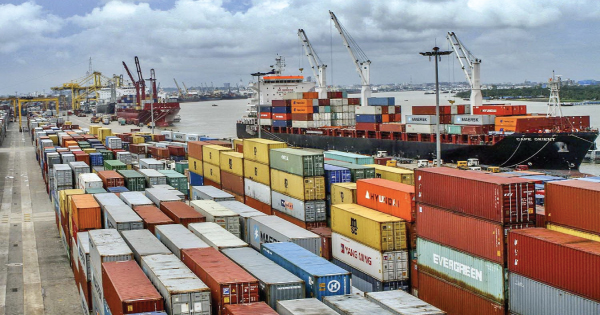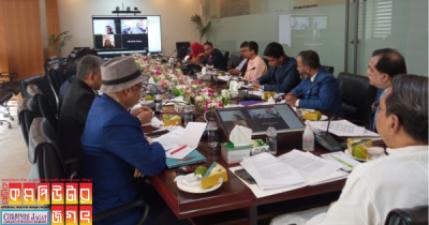Export Diversification Essential to Achieve SDGs by 2030
The readymade garments sector or RMG sector is a successful model for Bangladesh's exports but now it is time to focus on other potential sectors like leather, textiles, pharmaceuticals, ICT and light engineering. After the transition from the United Nations Least Developed Countries (LDCs), Bangladesh has started formulating long-term plans on how to increase its exports. These include low cost and easy access, adequate policy support as well as incentives for the non-garment export sector other than financial and non-financial incentives and ensuring equal skill development. We should pay more attention to the non-garment sector with good export potential. To diversify the country's exports so that it can help meet the existing and new challenges after the passage of LDC in 2026.
The local ICT sector earns about 1 billion a year but not everything is reported in a timely manner due to the lack of a payment system like a digital wallet or PayPal. We need to create a low-cost fund to ensure unconventional access to money for the development of this sector. About 80 percent of the drugs exported from Bangladesh are out of patent. For more than two decades, Bangladesh's policymakers have been talking about export diversification. It is also one of the initiatives of the recently concluded 'Bangladesh Trade and Investment Summit 2021', which reiterates the importance of policy and legal reforms to harness unused business opportunities at home and abroad. In fact, Bangladesh has been dependent on almost one sector for years for its export earnings.
Now no one knows when the share of readymade garments, which accounts for 84 percent of exports, will come down with the healthy growth of other industries and manufacturing. Leather and footwear, pharmaceuticals, ceramics, IT and software, jute products, light engineering products, assembling industries, handicrafts, frozen food, agro-based items and a few other sectors have been identified that can increase Bangladesh's foreign exchange earnings.
We need to facilitate more exports to countries in Latin America, Africa, Asia and the Middle East, in addition to the EU and the United States. The authorities need to identify the advantages of signing a free trade agreement or preferential trade agreement without considering only potential revenue gains. At present, Bangladesh earns 1 billion from the jute sector, but the industry could earn between 5 billion and 10 billion, given its growing international commitment to global climate change and sustainable development.
Relevant agencies should enforce domestic regulations which are very important for the preparation of WTO-approved industries. Also, strengthen the Bangladesh Standards and Testing Institute (BSTI) to ensure the quality of local products and to better test the quality of those that meet international quality tests. The legal capacity of the country also needs to be enhanced as trade disputes can increase significantly at the LDC transition stage. In order to compete in the international export market, small and medium industries like jute, agricultural processing, leather goods, footwear, pharmaceuticals, light engineering, ICT and other emerging sectors will have to face all kinds of competition. In addition to traditional industries, geographical diversity and the service sector.
Jute is now used in a variety of products and has become the second most sought-after natural fiber in the world. To be competitive we need to add value to this sector. About 70 percent of the total arable land in Bangladesh is used for paddy production, which employs about 45 percent of the country's rural labor force. We need to increase technology adaptation, increase private sector research and innovation, follow better agricultural practices and develop the country's post-harvest capacity and brand.
Bangladesh needs to achieve an investment environment. We like to receive praise from foreigners when they appreciate the progress of our social sector and the national ambition to become a middle-income country without extreme poverty by 2031 and a developed country by 2041. Traders should focus on research for product diversification and their branding in the field. Exports and trade. Traders can keep the market afloat and improve while maintaining product quality. We need to move forward by creating branding. In business, we need more research. Every business owner and entrepreneur determine the demand and quality of the product and takes the initiative to protect the image of their country by maintaining the quality of the product for export.
The age of technology in the world is moving very fast. Before the Fourth Industrial Revolution, we took steps to create skilled human resources. We have been able to continue all this during the pandemic where many countries around the world are facing problems. The government has been able to boost growth to 8 percent in the past and hopes to surpass it in the future. Bangladesh has completed a feasibility study on 23 countries for the implementation of bilateral and regional trade agreements, free trade agreements and integrated economic agreements to facilitating trade and commerce. In other words, as a developing country, we are working with special attention to address any challenges that may come our way.
Entrepreneurs involved in other potential non-garment sectors need to diversify their products and find new markets to increase their export earnings. It is very important to diversify textile products in line with the global market. The same thing may not always be a choice. Clothing design and colors have to change everything. Bangladesh ranks second in the world garment market. However, only 8.40 percent of the world market. So, we have to pay attention to this. We have to work hard to increase the demand for products in the world market. To achieve this goal-, short-, medium- and long-term plans need to be formulated. The private sector is at the forefront of the development and growth of the garment industry and especially the expansion of the international market. Therefore, the private sector should come forward in export diversification.
Thailand, a successful example of export diversification, has adopted a dual strategy to upgrade natural resource-based industries (such as agriculture and fisheries) and to encourage labor-intensive exports, especially clothing and electronics. All East Asian economies have benefited from the rise of regional economic integration with China. The integration of cross-country production networks has consolidated the position of production chains.
We have to think about product diversity, geographical diversity, quality diversity and service diversity from products. RMG exports are partially protected from exchange rate movements because of the special import credit system (back-to-back LC) that covers the cost of imports from export earnings. Non-RMG exports may be affected by the real effective exchange rate. Emergency resource management must be right for them. In order for export diversification to take place, an anti-export bias of the tariff system needs to be eliminated so that export products can be increased in addition to RMG. We need to think about four dimensions cost, quality, time and reliability. RMG is ahead of others in all these matters.
Globally, the two most commonly used indicators are the World Economic Forum, the Enabling Trade Index, and the World Bank's Trade Logistics Performance Index (LPI). In all sectors, Bangladesh has comparative advantages, but faces obstacles such as lack of skills, need to upgrade technology, weak infrastructure, or difficulty meeting international standards and compliance.
Bangladesh does poorly in most of the indices included in this index but the scores for transport and electricity are particularly low which has emerged as a serious obstacle in the manufacturing sector. It has been argued that low wages move from one place to another depending on the availability of unskilled labor. It is never good for a country to be completely dependent on a single source for export. Competition is a global practice and we should remember it.
For the economic development and sustainable growth of Bangladesh, export products need to be diversified. If this is possible, on the one hand, the dependence on one product will be reduced, on the other hand, the total export income will increase. Employment will increase. Women will also benefit.
However, the traders said that the government's help is needed for this. In particular, long-term funding, tax breaks, incentives and other assistance should be provided for setting up new factories. Besides, the businessmen have demanded to keep 1 billion in the budget separately. The negotiators have urged the traders to reduce the long time they have to travel to start any new business. The way the government has been giving incentives to the garment sector day after day; Traders have demanded equal incentives for other potential export sectors.
According to the report, 1600 types of products are exported from Bangladesh to different markets of the world. Eighty-five percent of the total export income comes from 292 types of readymade garments. Only 15 percent of the income comes from the remaining 13 hundred products. But out of these 1,300 products, there are a lot of products whose market is very big and the demand is constantly increasing. In particular, the market for leather and leather products, plastic products, light engineering products and medicines is growing. Bangladesh's capacity in these sectors is higher than in many countries. As a result, there is a huge possibility of increasing export earnings from these sectors if the government gets proper policy support.
Bangladesh's economy has grown from 7.3 to 7.9 percent in the last two years. According to the Bangladesh Bureau of Statistics, more than 20 lakh people have joined the labor force at this time. Bangladesh's economy is currently moving forward at a steady pace. The government has taken effective steps to diversify exports. There should be a comprehensive review of tax rates, tax collection methods and various incentives in the export sector. Because in many cases there are unnecessary initiatives. Again, research should be emphasized so that new products can be invented.
You can't depend on one product. The government needs to change its policy to take other export sectors forward. Vietnam does not have its own skin.
Again, the population is less. But Vietnam exports about 30 billion worth of leather and leather products annually. But despite Bangladesh having its own leather and adequate manpower, the export is one billion dollars. The demand for plastics is growing worldwide. There are many possibilities in this industry. However, the government's policy support must be increased. The world economy is now recovering from the impact of Covid. International trade has gained momentum. This is also reflected in the country's export sector. According to the Bangladesh Export Promotion Bureau (EPB), Bangladesh has exported more goods than expected by the government. As always, the ready-made garment sector is playing a big role in the rise in exports. The pace of exports is also positive for several other products, including leather and leather products.
Exports from Bangladesh have been 5.65 percent more than the target. On the other hand, in the last financial year, the export was 979 crore 8 lakh 40 thousand dollars. As a result, exports have increased by 11.38 percent compared to the same period last year. The top three categories of products exported from Bangladesh are readymade garments, jute and jute products and leather and leather products.
Efforts should be made to diversify export products and create new markets by exploiting the potential of the signature. Which can assist us in the implementation of SDGs. Initiatives should be taken to export different types of products without restricting the export trade in certain products. Due to the promotion of international standards, the demand for different types of Bangladeshi products has been created in different countries. Some of the companies in Bangladesh have achieved unprecedented success, especially in the field of food and agricultural exports. The products of several brands in Bangladesh have gained international fame, which has created bright prospects for the expansion of the market.







.png)






০ টি মন্তব্য